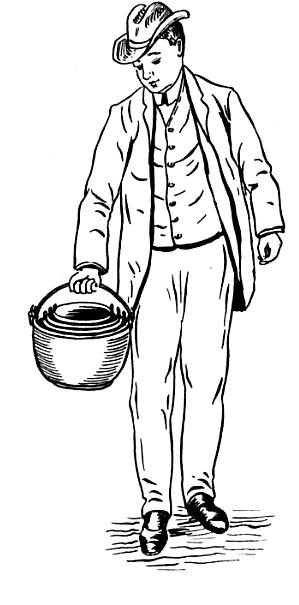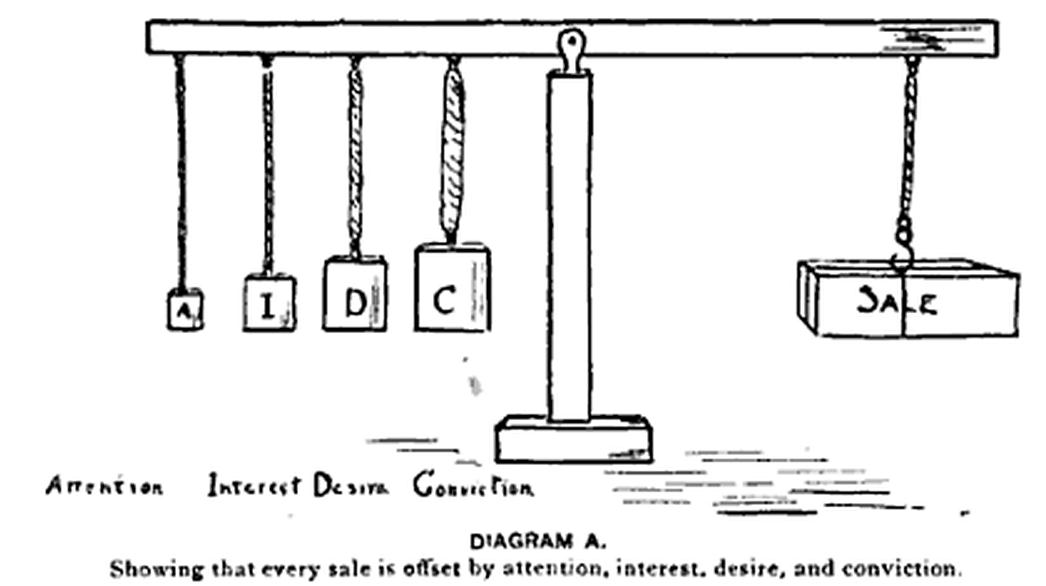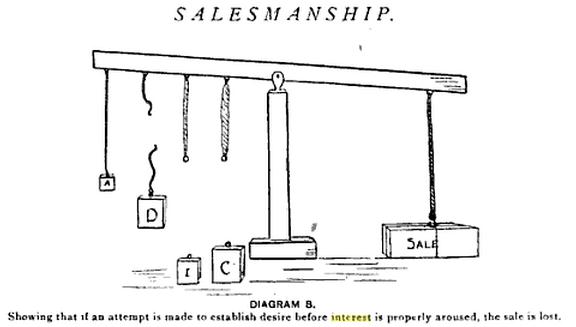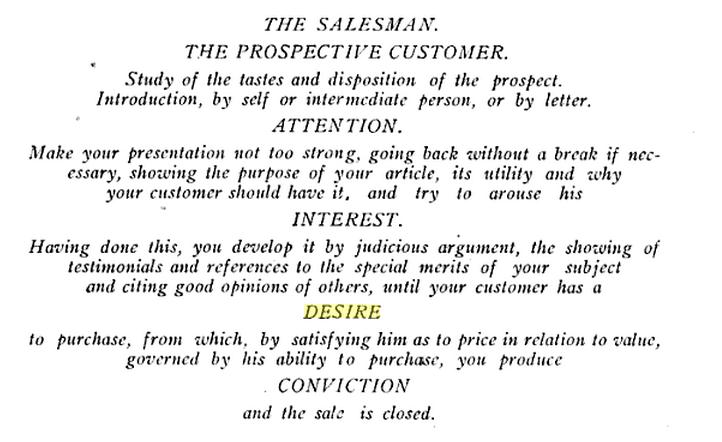The AIDA Model & Elias St. Elmo Lewis
While writing Social Marketology, my new book on social media marketing, I get fixated on a particular fact and spend countless hours researching. One fact that has consumed more of my time than any other is the idea that a guy named Elias St. Elmo Lewis invented an oft-cited marketing concept of AIDA (acronym for “attention, interest, desire, action”). AIDA is often part and parcel of something called the customer funnel, sales funnel, and marketing funnel. Derrick White, in his 2000 book “Close More Sales,” wrote “AIDA is probably the oldest acronym in marketing. It is the best and will never change.”
Who Really Created AIDA?
Yes, and this is an interesting point: the fact that St. Elmo Lewis created the concept is cited in dozens of marketing books and hundreds upon hundreds of websites. Problem: I can’t find any original source to validate this.
In Advertising, Selling, and Credits by Ralph Starr Butler, 1911, The four steps are the subject of a whole chapter, and says “Mr. A. F. Sheldon was probably the first to point out the presence of these four steps in every sale” Mr. A.F. Sheldon was the founder of the Sheldon School of Scientific Salesmanship.
It turns out I haven’t been the first person to spend too much time on this concept. Author Ian Moore, in Does Your Marketing Sell (2005), added an item in the appendix titled, “The origins of AIDA.” He demonstrates how Strong wasn’t using the acronym, but cited Lewis. And then Strong was then cited by none other than the famous business author Philip Kotler as the author of the AIDA concept.
But Strong had written “The development of the famous slogan – ‘attention, interest, desire, action, and satisfaction’ – illustrates this. In 1898 E. St. Elmo Lewis used the slogan, ‘Attract attention, maintain interest, create deire,’ in a course he was giving on advertising in Philadelphia. He writes he obtained the idea from reading the psychology of William James. Later on he added the formula, ‘get action.’ About 1907, A.F. Sheldon made the further addition of ‘permanent satisfaction’ as essential to the slogan.”
Now, first off, many of the citations of Lewis state that he came up with AIDA in 1898 while working at the National Cash Register Company – an organization that really was probably one of the most advanced companies in sales process. Only Lewis didn’t work there until 1902, and only seemed to have remained there until 1904. Prior to that, he was a publisher of various artsy periodicals back in Philadelphia.
Lewis was a brilliant thinker, and wrote a few books, countless articles, and gave talks at Rotary Clubs, Chambers, and other organizations all over the Northeast. Thanks to Google Books, I’ve been able to dig into many of them, and I’ve yet to come across a mention of the old “attention, interest, desire” triad. He was an appreciator of the Efficiency Movement, and did work to bring the philosophy of scientific management to salesmanship and advertising. I haven’t found anything, though, to suggest that Lewis was the originator of the concept.
So, who did?
The earliest version of marketing AIDA I’ve found is this:
Attention. Interest. Desire. Conviction. A diagram showing that every sale is offset by attention, interest, desire, and conviction. From Frank Hutchinson Dukesmith, editor of 1904 Salesmanship
Over and over in this magazine from 1904, they mention these steps. “A sale of any kind has four essential parts: Attention, Interest, Desire, and Conviction. Take these in their proper order. Do not mistake polite attention for interest and do not assume when a desire for possession is aroused that conviction has been reached. In loss of sales it is as disastrous as to not close the sale when conviction is reached.”
Frank Hutchinson Dukesmith authored the pieces above. His other claim to fame was that he also edited “The Air Brake Magazine,” dedicated to railroad air brakes. He also authored a book, “The air brake, its use and abuse: a book of instruction on the automatic air brake.” And as you might know, air brakes were how George Westinghouse made his fortune! Dukesmith held many patents for his inventions to the technology of air brakes.
Perhaps Dukesmith took a course being taught by St. Elmo Lewis. Or perhaps St. Elmo Lewis read Dukesmith’s article (he also wrote a book Salesmanship analyzed;: Being an analytical treatise on the science of salesmanship demonstrated by diagramatic charts). At any rate, his patents for air brakes must not have been lucrative, as by 1910, Dukesmith had created the “Dukesmith School of Salesmanship” in Meadville, PA.
Another passage:
It is not to be supposed that every sale will be landed in one, two, three order, for many will be lost, but an understanding of the science of salesmanship, with correct practice in the art of selling, will tend to cut down the number of lost sales. The science of medicine does not eliminate disease. But it diminishes its ravages.
In the specialty field where, as shown, the divisions are more clearly marked, the salesman himself has more opportunity to arrange and prepare himself in advance. Nevertheless, the same principles apply to every sale, and even a newsboy on the street must obtain attention, arouse interest, and create desire before he makes the sale of a paper.
 To still further illustrate this same principle of four parts to the sale we may regard the putting together of the four iron vessels (here pictured), as representing the sale or transaction. We assume that it would be impossible for the salesman to carry away the four pots separately and that to make them movable he must place them compactly together. There is but one way in which the pots can be properly put together, and that is by placing inside the largest the next smaller, and so on, whereby all are compactly arranged and can be easily carried away. The pots must be put one within the other in proper order, by taking at each operation the one next smaller; otherwise, one of the two intermediate sizes is left out, for they cannot be all put together except in regular order. You cannot complete your sale by leaving out the factor of interest5, nor can you produce conviction and close the sale until the customer has arrived at the stage of desire to possess the goods.
To still further illustrate this same principle of four parts to the sale we may regard the putting together of the four iron vessels (here pictured), as representing the sale or transaction. We assume that it would be impossible for the salesman to carry away the four pots separately and that to make them movable he must place them compactly together. There is but one way in which the pots can be properly put together, and that is by placing inside the largest the next smaller, and so on, whereby all are compactly arranged and can be easily carried away. The pots must be put one within the other in proper order, by taking at each operation the one next smaller; otherwise, one of the two intermediate sizes is left out, for they cannot be all put together except in regular order. You cannot complete your sale by leaving out the factor of interest5, nor can you produce conviction and close the sale until the customer has arrived at the stage of desire to possess the goods.
Frank Hutchinson Dukesmith and Marketing AIDA
Frank Hutchinson Dukesmith has pretty much been forgotten by history, and yet, it appears he was the author of one of the most enduring concepts, still taught today in business schools around the world. He was certainly the first to publish the concept, while St. Elmo Lewis’ claim is second-hand, and came 20 years after Dukesmith published. You might wonder why anyone should care – yet if simple errors like this can become re-cited thousands of times over, it emphasizes the notion that writers have an obligation to recheck facts, and find original source material whenever possible.
By the way, the first published use of the AIDA acronym is from 1921, in Printers Ink, “How to Write a Sales-Making Letter” by C.P. Russell:
An easy way to remember this formula is to call in the “law of association,” which is the old reliable among memory aids. It is to be noted that, reading downward, the first letters of these words spell the opera “Aida.” When you start a letter, then, say “Aida” to yourself and you won’t go far wrong, at least as far as the form of your letter is concerned.
The idea of a “customer funnel,” “marketing funnel,” or “sales funnel” in association with the AIDA concept was first proposed in Pharmaceutical Selling, “detailing,” and sales training by Arthur F. Peterson, Heathcote-Woodbridge, 1959.
I think I can lay this to bed now, and get back to the book!
Tags: customer funnel, Frank Hutchinson Dukesmith, Ralph Starr Butler, St. Elmo Lewis
'Marketing > AIDA' 카테고리의 다른 글
| [스크랩] Time to update the AIDA model (0) | 2013.07.13 |
|---|---|
| [스크랩] Online Marketing: Breaking Down the AIDAS Mode (0) | 2013.07.13 |
| [스크랩] 고객 구매 결정 단계에 대한 이해 (0) | 2013.07.13 |
| [스크랩] [인터뷰]텍스트 마이닝 전문가 카나야마 히로시 박사 ;; AIDA (0) | 2013.07.13 |
| [스크랩] Beyond the AIDA Marketing Principle (0) | 2013.07.13 |









